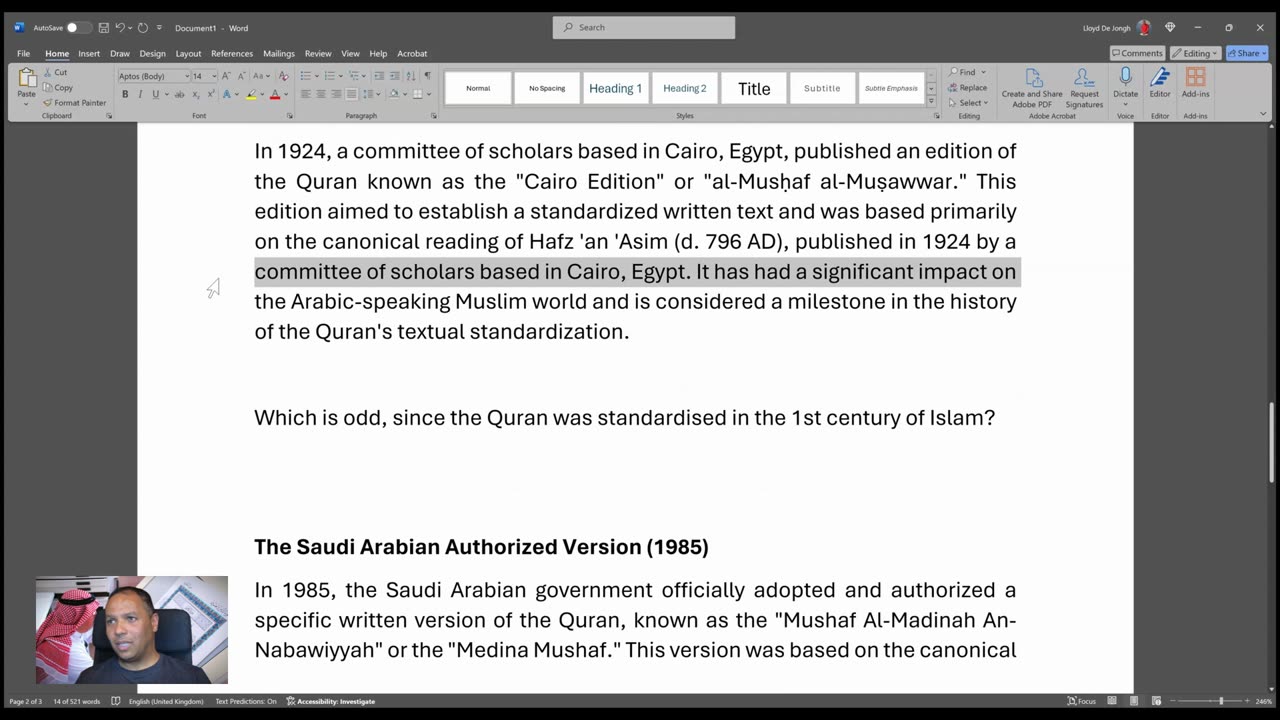Premium Only Content

The Quran was Perfectly Preserved - but in 1985
If the Quran was always 'perfectly preserved', why was it only canonised in 1985?
While the Quran was supposedly compiled during the time of the Prophet Muhammad and the Rightly Guided Caliphs in the 7th century CE, there have been efforts over the centuries to establish authoritative versions and readings of the text.
Which is odd, since it's been perfectly preserved, we are told?
Here are some key points with evidence:
Multiple Canonical Readings
The Quran has been transmitted through multiple canonical readings or "qira'at" that were accepted by early Islamic scholars. These include the readings of:
Qalun (d. 835 AD)
Warsh (d. 812 AD)
Al-Bazzi (d. 864 AD)
Qunbul (d. 904 AD)
Al-Duri (d. 860 AD)
Al-Susi (d. 874 AD)
Hisham (d. 859 AD)
Ibn Dhakwan (d. 857 AD)
Shu'bah (d. 809 AD)
Hafz (d. 796 AD)
Khalaf (d. 844 AD)
Khallad (d. 835 AD)
Al-Layth (d. 854 AD)
Isa Ibn Wardan (d. 777 AD)
Ibn Jummaz (d. 787 AD)
Ruways (d. 853 AD)
Rawh (d. 849 AD)
Ishaq (d. 899 AD)
Idris (d. 905 AD)
These readings, while differing slightly in pronunciation and orthography, were all considered authentic transmissions of the Quranic text.
The Cairo Edition (1924)
In 1924, a committee of scholars based in Cairo, Egypt, published an edition of the Quran known as the "Cairo Edition" or "al-Musḥaf al-Muṣawwar." This edition aimed to establish a standardized written text and was based primarily on the canonical reading of Hafz 'an 'Asim (d. 796 AD), published in 1924 by a committee of scholars based in Cairo, Egypt. It has had a significant impact on the Arabic-speaking Muslim world and is considered a milestone in the history of the Quran's textual standardization.
Which is odd, since the Quran was standardised in the 1st century of Islam?
The Saudi Arabian Authorized Version (1985)
In 1985, the Saudi Arabian government officially adopted and authorized a specific written version of the Quran, known as the "Mushaf Al-Madinah An-Nabawiyyah" or the "Medina Mushaf." This version was based on the canonical reading of Hafz 'an 'Asim, following the Cairo Edition of 1924, was printed by the King Fahd Complex for the Printing of the Holy Qur'an in Medina. It has been widely distributed globally.
There is no complete Uthmanic manuscript from the 7th century. The earliest relatively complete manuscripts like the Topkapi and Sana'a date to the late 7th and early 8th centuries.
The Sana'a manuscript contains significant variations in its lower text compared to the standard Uthmanic text, indicating textual diversity before canonization. The Sana'a Palimpsest indicates a period of textual diversity before the canonization of the Quranic text.
Early manuscripts show variations in areas like surah order, surah names, verse numbering systems compared to the standard text.
Muslim sources mention the possibility of verses being added/removed in the compilation process under Uthman based on hadith reports.
Muslim sources acknowledge debates among Islamic scholars about the extent of editing and variants in the pre-Uthmanic period.
Muslim sources indicate there were variants and an evolution of the textual tradition, especially pre-canonization.
Recent scholarship identifies Abd al-Malik as the one who canonised the Quran, not Uthman.
-
![GrayZone Warfare: NightOp [GAME GIVEAWAY!] - #RumbleGaming](https://1a-1791.com/video/s8/1/s/1/R/D/s1RDv.0kob-small-GrayZone-Warfare-NightOp-GA.jpg) LIVE
LIVE
LumpyPotatoX2
1 hour agoGrayZone Warfare: NightOp [GAME GIVEAWAY!] - #RumbleGaming
541 watching -
 LIVE
LIVE
WeAreChange
2 hours agoAliens?! Pentagon Shoots Down Iranian Mothership Drone Narrative
2,857 watching -
 UPCOMING
UPCOMING
The StoneZONE with Roger Stone
1 hour agoShould the January 6th Committee be Investigated? | The StoneZONE w/ Roger Stone
408 -
 44:34
44:34
PMG
1 hour ago"Caitlin Clark Says She Has “White Privilege” Why Caitlin WHY???"
27 -
 1:06:50
1:06:50
Dr. Drew
8 hours agoRoger Ver, Jan 6ers, Ross Ulbricht: Who Should Trump Pardon First? w/ Robert Barnes & Aaron Day – Ask Dr. Drew
21.6K2 -
 11:56
11:56
Tundra Tactical
2 hours ago $0.24 earnedWas the UnitedHealthcare CEO Assassination a PSYOP?
1.43K -

Sarah Westall
1 hour agoPower of Nocebo and Placebo in Health & Politics. Quantum Energy Advancements w/ Ian and Philipp
6.64K1 -
 LIVE
LIVE
LFA TV
22 hours agoLee Smith Discusses ‘Disappearing the President’ | Trumpet Daily 12.11.24 7PM EST
300 watching -
 LIVE
LIVE
2 MIKES LIVE
3 hours ago2 MIKES LIVE #154 w/ Spcieal Guests, BRIANNE DRESSEN, DAN SMERIGLIO and ADAM DERITO!
141 watching -
 1:28:46
1:28:46
Redacted News
5 hours agoBREAKING! CIA DEEP STATE PLAN TO STOP TRUMP ACCELERATES WITH FALSE FLAGS TIED TO IRAN | REDACTED
142K271